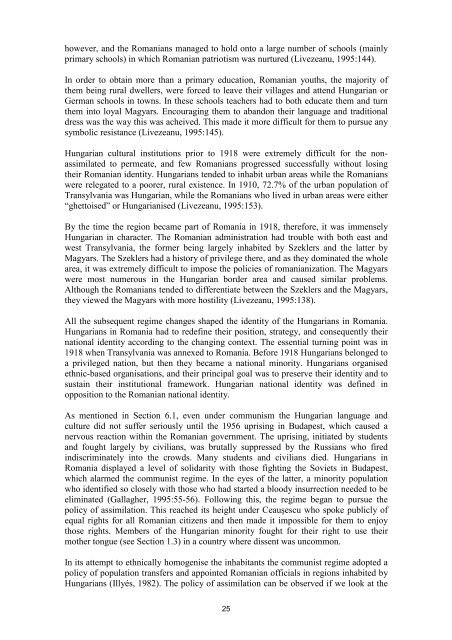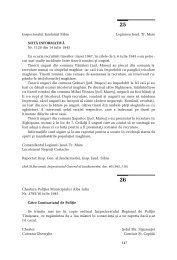Southeast Europe
Southeast Europe
Southeast Europe
Create successful ePaper yourself
Turn your PDF publications into a flip-book with our unique Google optimized e-Paper software.
however, and the Romanians managed to hold onto a large number of schools (mainly<br />
primary schools) in which Romanian patriotism was nurtured (Livezeanu, 1995:144).<br />
In order to obtain more than a primary education, Romanian youths, the majority of<br />
them being rural dwellers, were forced to leave their villages and attend Hungarian or<br />
German schools in towns. In these schools teachers had to both educate them and turn<br />
them into loyal Magyars. Encouraging them to abandon their language and traditional<br />
dress was the way this was acheived. This made it more difficult for them to pursue any<br />
symbolic resistance (Livezeanu, 1995:145).<br />
Hungarian cultural institutions prior to 1918 were extremely difficult for the nonassimilated<br />
to permeate, and few Romanians progressed successfully without losing<br />
their Romanian identity. Hungarians tended to inhabit urban areas while the Romanians<br />
were relegated to a poorer, rural existence. In 1910, 72.7% of the urban population of<br />
Transylvania was Hungarian, while the Romanians who lived in urban areas were either<br />
“ghettoised” or Hungarianised (Livezeanu, 1995:153).<br />
By the time the region became part of Romania in 1918, therefore, it was immensely<br />
Hungarian in character. The Romanian administration had trouble with both east and<br />
west Transylvania, the former being largely inhabited by Szeklers and the latter by<br />
Magyars. The Szeklers had a history of privilege there, and as they dominated the whole<br />
area, it was extremely difficult to impose the policies of romanianization. The Magyars<br />
were most numerous in the Hungarian border area and caused similar problems.<br />
Although the Romanians tended to differentiate between the Szeklers and the Magyars,<br />
they viewed the Magyars with more hostility (Livezeanu, 1995:138).<br />
All the subsequent regime changes shaped the identity of the Hungarians in Romania.<br />
Hungarians in Romania had to redefine their position, strategy, and consequently their<br />
national identity according to the changing context. The essential turning point was in<br />
1918 when Transylvania was annexed to Romania. Before 1918 Hungarians belonged to<br />
a privileged nation, but then they became a national minority. Hungarians organised<br />
ethnic-based organisations, and their principal goal was to preserve their identity and to<br />
sustain their institutional framework. Hungarian national identity was defined in<br />
opposition to the Romanian national identity.<br />
As mentioned in Section 6.1, even under communism the Hungarian language and<br />
culture did not suffer seriously until the 1956 uprising in Budapest, which caused a<br />
nervous reaction within the Romanian government. The uprising, initiated by students<br />
and fought largely by civilians, was brutally suppressed by the Russians who fired<br />
indiscriminately into the crowds. Many students and civilians died. Hungarians in<br />
Romania displayed a level of solidarity with those fighting the Soviets in Budapest,<br />
which alarmed the communist regime. In the eyes of the latter, a minority population<br />
who identified so closely with those who had started a bloody insurrection needed to be<br />
eliminated (Gallagher, 1995:55-56). Following this, the regime began to pursue the<br />
policy of assimilation. This reached its height under Ceauşescu who spoke publicly of<br />
equal rights for all Romanian citizens and then made it impossible for them to enjoy<br />
those rights. Members of the Hungarian minority fought for their right to use their<br />
mother tongue (see Section 1.3) in a country where dissent was uncommon.<br />
In its attempt to ethnically homogenise the inhabitants the communist regime adopted a<br />
policy of population transfers and appointed Romanian officials in regions inhabited by<br />
Hungarians (Illyés, 1982). The policy of assimilation can be observed if we look at the<br />
25









